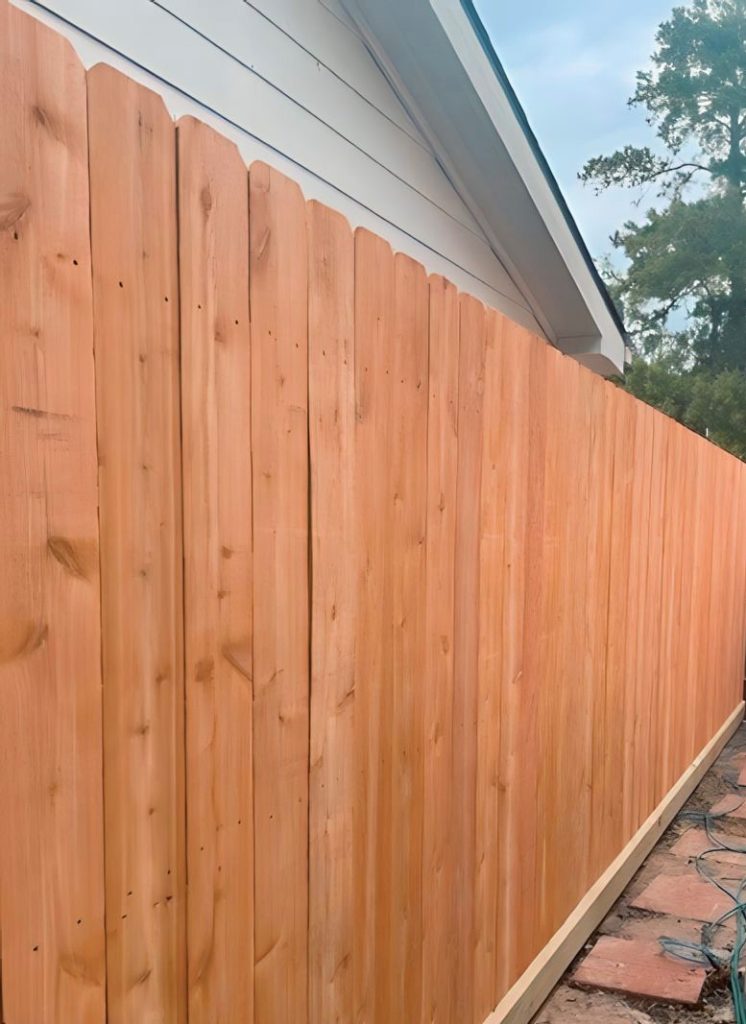Guide to Installing and Maintaining Western Red Cedar Fences
Western Red Cedar is a popular choice for building fences due to its natural durability, resistance to decay and insects, as well as its beautiful appearance. This type of wood is known for its stability and longevity, making it an excellent option for creating sturdy and visually appealing fences. Read on to find out why this is such a popular choice for most wood fences that Texas Fence builds.

Benefits of Western Red Cedar Fences
Let’s talk about why Western Red Cedar is such a popular choice for fences. First of all, this wood has natural properties that make it resistant to decay, meaning it can last a long time without deteriorating or needing extensive maintenance. The natural oils present in the wood act as preservatives, making it able to withstand various weather conditions, be it harsh sunlight or heavy rain.
Natural Decay Resistance and Durability
When considering a fence material, durability is key. Western Red Cedar ranks high in this aspect. Its natural resistance to decay and insects makes it lower maintenance than many other types of wood. This means less worry once your fence is up—no need for constant repairs or replacement—a significant time, effort, and money saver in the long run.
Moreover, the beauty is not just skin deep; the distinct grain patterns and warm coloring give your fence a naturally stunning appearance that enhances the curb appeal of your property. It adds value to your home by not only providing a secure boundary but also offering an aesthetic boost.
It’s satisfying to have something both beautiful and hard-working in our lives.
Insect Resistance
The natural oils present in Western Red Cedar also act as a deterrent for various pests. The distinct aroma of the cedar acts as a natural barrier against moths, termites, and other pests. This increases longevity and reduces the potential damage that insects could cause to your fence.
Lightweight and Easy Installation
Moreover, Western Red Cedar is relatively lightweight compared to other wood species used for fencing. This makes it easier to handle and work with during installation. Whether you’re installing it yourself or relying on professional installation services, this advantage makes the entire process smoother and more manageable.
In summary, opting for Western Red Cedar for your fencing needs offers numerous advantages—from its natural decay resistance and durability to its beautiful appearance and ease of installation. It’s clear why this material has gained such popularity among homeowners looking for reliable and attractive fencing solutions.
With a clearer understanding of the benefits offered by Western Red Cedar fences, let’s now take a closer look at how you can go about setting up one on your property.
Setting Up Your Western Red Cedar Fence
Installing a fence can seem daunting, but seeing your Western Red Cedar fence standing tall and sturdy is genuinely rewarding. It can transform the appearance of your property while providing privacy and security. With the right guidance, setting up your fence can save you money and be a fulfilling project to take on.
Taking things slow and planning carefully has always been our model when it comes to setting up a wooden fence. Here’s an overview of steps that should guide you through the process:
Obtain Necessary Permits
Before you think about ordering materials or digging post holes, it’s crucial to check with local authorities or homeowner associations to acquire any required permits. Neglecting this step can result in legal issues later in the installation process, possibly leading to the removal of the entire fence if it doesn’t abide by local regulations.
Plan the Layout
Once you have the green light from local authorities, it’s time to carefully measure the area where you intend to install the fence and mark the spots for post holes accurately. Planning out the layout ensures you get precise measurements for materials and helps you avoid last-minute adjustments.
Spend a good amount of time measuring and marking so that your layout is clear and well-prepared for the following steps.
Digging Post Holes
The quality and lifespan of a fence are significantly influenced by the stability of its posts. Use a post hole digger to create holes at regular intervals along your marked spots. Ensuring proper depth is crucial for maintaining structural integrity, especially as it will directly impact how well each post supports the weight of the panels once installed.
Keep in mind: The appropriate depth depends on factors such as soil composition and weather conditions in your area, so make sure you research these specifics before starting work.
Installing the Posts and Panels
Setting the posts is one of the most important parts of building a wood fence. Once you have dug all your post holes, it’s time to place your posts. After setting them upright in concrete or gravel, correctly attaching panels ensures they are level and securely fastened to the posts.
Remember, installing posts firmly guarantees that they will securely support panels over time without leaning or sagging.
Carrying out each step with care allows you to build not just a simple wooden barrier but a durable slice of architecture that adds value to your home in many ways!
Types of Western Red Cedar Fences
Solid Board Fences: Made up of individual boards joined tightly, creating a seamless barrier for privacy and noise reduction. It’s perfect for creating a secluded backyard space where you want to relax without interruptions.
These fences are tall, offering excellent privacy and reducing external noise. The natural rich color and texture of Western Red Cedar add warmth and beauty to your outdoor space, making it pleasant to look at while providing a sense of security. Regular maintenance is key to keeping it looking good and in good shape.
Spaced Picket Fences
Unlike solid board fences, this style features evenly spaced vertical boards, allowing wind to pass through, ensuring good airflow and visibility into and out of your yard. This kind of fence can make your front yard feel welcoming while also keeping it safe and private.
Do you have a lovely garden or an attractive landscaping feature? This type of fence would work perfectly to showcase these while also acting as a boundary. These picket fences give an open, friendly feeling, ideal for homes with children or pets. The lack of complete privacy does not compromise safety and can make your home more inviting.
Shadowbox Fences
Shadowbox fences create a dynamic visual effect by alternating panels on each side of the supporting rails. This unique design provides an attractive look from both sides, making it suitable for shared property lines. If you have neighbors living close by or want to have distinct appearances on either side of the fence, this option could be ideal for you.
The smart design lets air flow through but still ensures a level of privacy. It’s visually appealing and might be worth considering if you’re looking for something that looks good from inside and outside your property. Different households often have very different tastes, so having two appealing faces can make this type of fence an excellent choice for shared boundaries.
By understanding the various types of Western Red Cedar Fences, you can tailor your selection based on specific needs and preferences, ensuring that your fencing serves its practical purpose while adding aesthetic value to your property.
Understanding the range of Western Red Cedar fencing options paves the way for an insightful comparison with other available fence types.
Western Red Cedar vs Other Fence Types
When comparing Western Red Cedar with pressure-treated pine, one notable difference lies in their natural resistance to decay and insects. Unlike pressure-treated pine, Western Red Cedar does not require chemical treatments for protection against decay and insects. This gives it a clear advantage in terms of sustainability and environmental impact.
Pressure-treated pine often needs to be treated with chemicals such as chromate copper arsenate (CCA) or alkaline copper quaternary (ACQ) to match the level of decay and insect resistance that Western Red Cedar naturally possesses. Considering this, it’s evident why Western Red Cedar is more popular for those who prioritize environmentally friendly and sustainable building practices.
Similarly, when comparing Western Red Cedar with redwood, both woods are naturally durable. However, Western Red Cedar stands out for being more dimensionally stable, offering comparable durability at a lower cost. This makes it an attractive choice for those seeking long-lasting quality without a premium price tag.
Redwood is known for its natural beauty and longevity, but it tends to be considerably more expensive than Western Red Cedar. Additionally, redwood is less widely available, which can make sourcing and purchasing it more challenging compared to Western Red Cedar. For many homeowners, these factors make Western Red Cedar a practical and budget-friendly option without sacrificing durability and aesthetics.
Moreover, in the comparison between Western Red Cedar versus Vinyl, the key differentiator is maintenance. While vinyl fences require almost zero maintenance, providing longevity without much effort, Western Red Cedar evokes a natural, rustic appearance and is biodegradable.
For those seeking a fence material that ages gracefully over time while blending seamlessly into the surrounding environment, Western Red Cedar is the ideal choice. Its weathered look enhances its natural appeal; in contrast, vinyl may lack the organic charm and warmth that Western Red Cedar exudes.
Understanding these differences allows homeowners to make informed decisions based on their preferences for durability, environmental impact, maintenance requirements, and aesthetics when choosing the best fence type for their property.
Ensuring Longevity: Maintenance Tips
When you invest in Western Red Cedar fencing, ensuring its longevity should be a priority. Regular care not only keeps the fence looking great but also prevents deep-seated damage and extends its lifespan. Here are some essential tips to maintain the beauty and integrity of your cedar fence.
Regular Cleaning
Keeping your cedar fence clean is fundamental to maintenance. Dust, dirt, and debris can accumulate over time, causing discoloration and potentially leading to damage. To preserve the wood’s appearance, experts recommend cleaning the fence regularly with a gentle detergent and water. This simple step goes a long way in preventing unsightly buildup and preserving the natural beauty of the wood.
Regular cleaning also allows you to detect any early signs of wear or damage, enabling prompt action to address issues before they worsen. This not only safeguards the visual appeal but also enhances the overall longevity of the fence.
Applying Sealant
One of the key factors that can impact the durability of Western Red Cedar fencing is exposure to moisture and UV rays. To shield the wood from these elements, applying a high-quality sealant is vital. It is recommended to reapply a quality sealant every few years to maintain the fence’s integrity and protect it from weathering. The sealant acts as a protective barrier, significantly reducing the potential for water damage and minimizing the effects of sunlight exposure.
This proactive approach significantly contributes to preserving your cedar fence’s natural beauty while shielding it from environmental factors that could lead to degradation over time.
Inspecting for Damage
In addition to regular cleaning and sealant application, conducting thorough inspections is critical for identifying and addressing potential issues promptly. Routinely inspect the fence for any signs of damage, such as loose boards, cracks, or insect activity.
Some might view these maintenance tasks as time-consuming or unnecessary. However, taking this proactive approach will save you time and resources in the long run by mitigating the risk of more significant damage occurring.
Adhering to these maintenance tips empowers you to preserve the natural beauty and integrity of your Western Red Cedar fence, ensuring that it continues to enhance your property for many years to come.
Understanding how maintenance plays an instrumental role in maximizing the value of your Western Red Cedar fence is crucial. Now, let’s delve into understanding the cost factors influencing these valuable fencing solutions.
Understanding the Cost of a Western Red Cedar Fence
When installing a Western Red Cedar fence, various crucial factors come into play in determining its cost. The fence height, linear footage, design complexity, and the cost of materials are all instrumental in calculating the total expense.
Unlike other premium woods, Western Red Cedar offers substantial value and is competitively priced. While the initial costs may seem higher than some options, its combination of durability and natural aesthetics makes it a sound long-term investment.
For instance, if you’re considering a six-foot tall cedar picket fence, the linear footage may vary depending on the spacing between the pickets. A complex design with detailed lattice patterns or custom woodworking will naturally increase installation time and add to the cost.
However, this initial investment often pays off by minimizing long-term maintenance costs and providing an attractive, enduring feature for your property.
In many ways, investing in a Western Red Cedar fence is akin to choosing quality furniture over mass-produced options. Although the immediate expense may be higher, its longevity and timeless appeal make it well worth the cost.
If you have more questions or need assistance in choosing the right fencing options for your property, feel free to contact our experts who will guide you through every step of the process. Or call us at (281) 807-7900.








